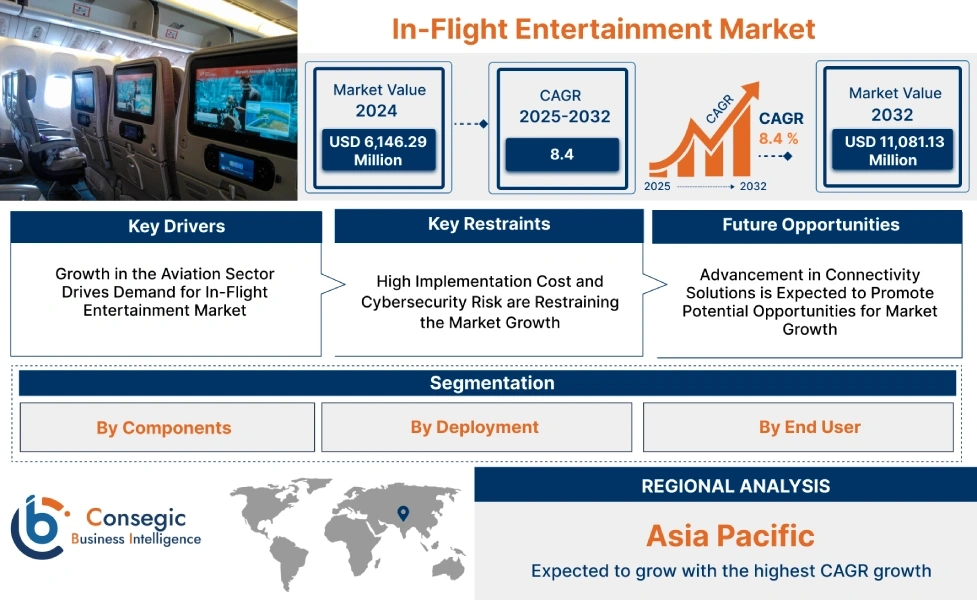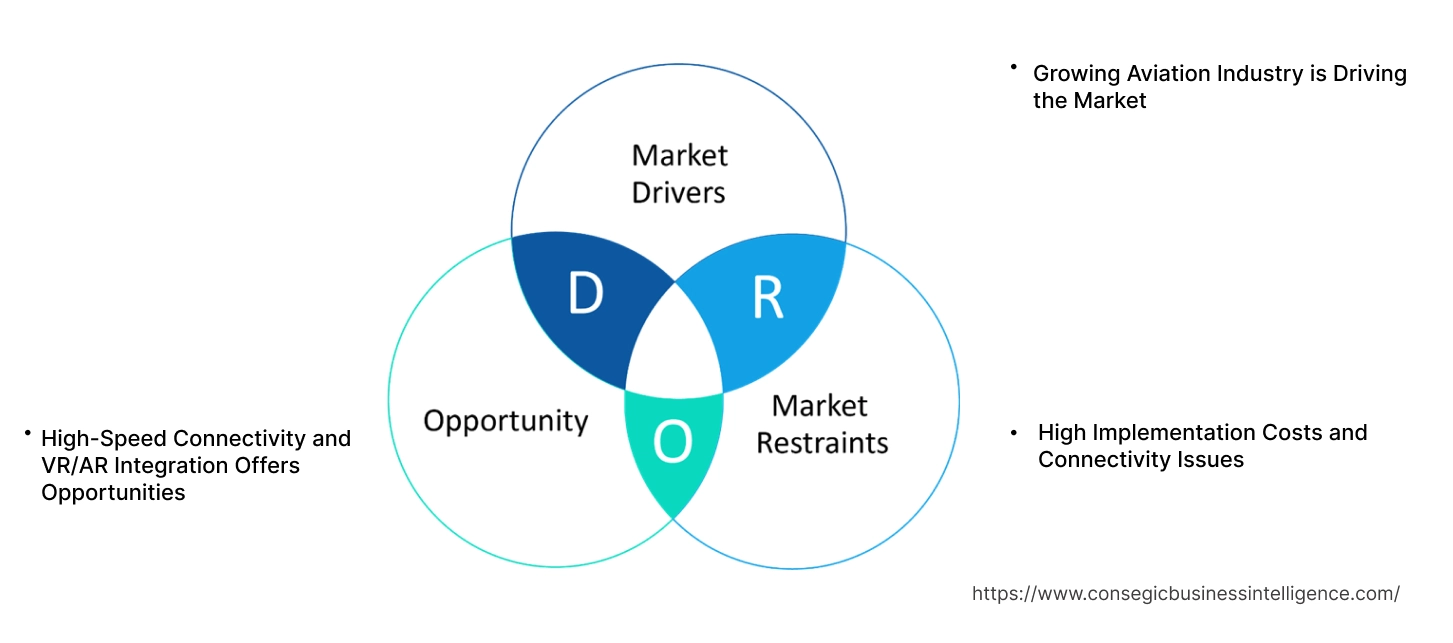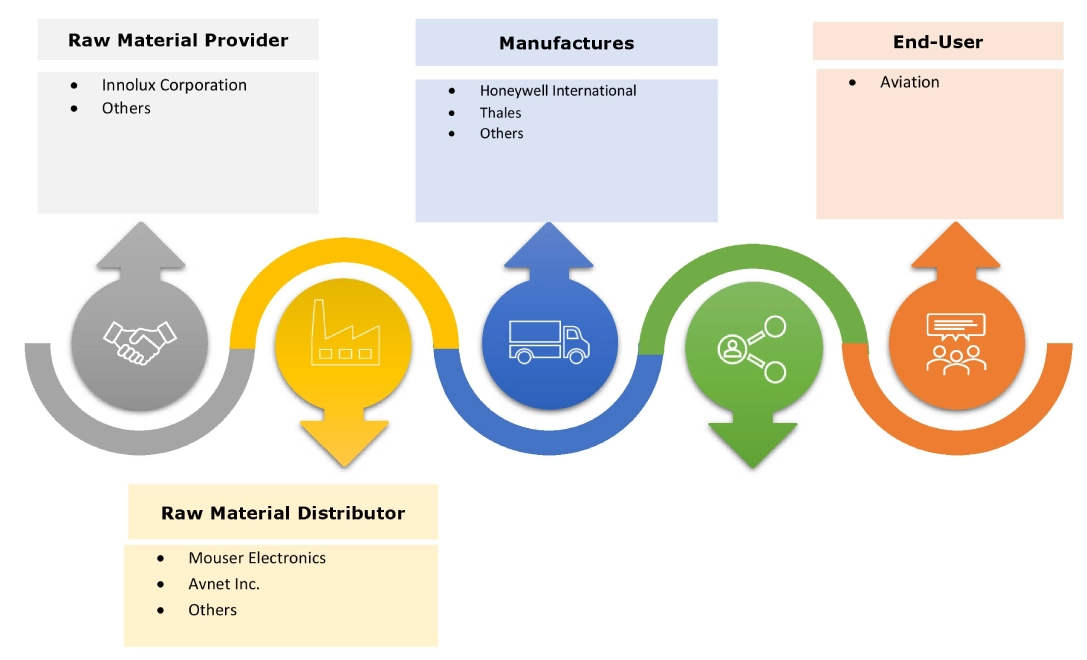- Summary
- Table Of Content
- Methodology
In-Flight Entertainment Market Size:
In-Flight Entertainment Market is estimated to reach over USD 11,081.13 Million by 2032 from a value of USD 6,146.29 Million in 2024 and is projected to grow by USD 6,509.29 Million in 2025, growing at a CAGR of 8.4% from 2025 to 2032.
In-Flight Entertainment Market Scope & Overview:
In-Flight Entertainment (IFE) market is a sophisticated network of hardware and software that provides passengers with a range of entertainment options during air travel. This includes individual screens at each seat, larger screens in the cabin, Wi-Fi systems, media servers, and headphones. The software component encompasses content management systems, interactive interfaces, and applications for games and other features. The market is driven by increasing passenger expectations for a more engaging and personalized travel experience. Further, key trends shaping the IFE market include the demand for high-speed connectivity, personalized content recommendations, and the rise of Bring-Your-Own-Device (BYOD) solutions. Furthermore, advancements in technology, such as high-definition displays and virtual reality (VR), are also contributing to the evolution of IFE systems.
Key Drivers:
Growing Aviation Industry is Driving the Market
The burgeoning aviation industry is a key driver of the in-flight entertainment market. As air travel demand surges, airlines strive to enhance passenger experiences. In-flight entertainment systems, with their diverse content libraries and interactive features, have become crucial differentiators. Further, the increasing number of air travelers, coupled with a growing focus on passenger comfort and satisfaction, compels airlines to invest in advanced IFE systems. This creates a robust market for content providers, hardware manufacturers, and service providers, fueling significant market growth.
For instance, according to Boeing’s Commercial Market Outlook (CMO), South Asia aviation market is set for explosive growth, with its fleet size expected to quadruple within the next 20 years to keep pace with surging passenger demand, particularly `
Key Restraints:
High Implementation Costs and Connectivity Issues
High implementation costs and connectivity issues pose significant challenges to the in-flight entertainment market. The installation and maintenance of advanced IFE systems, particularly those with high-definition screens, broadband internet, and interactive features, necessitates substantial upfront investment for airlines. These costs encompass hardware, software, content licensing, and ongoing maintenance. Such expenses can be a considerable barrier for smaller airlines, hindering their ability to offer competitive IFE experiences.
Furthermore, ensuring reliable and high-speed internet connectivity during flight presents numerous obstacles. Atmospheric interference and the need for specialized ground infrastructure significantly increase costs. Inconsistent connectivity can frustrate passengers and diminish the effectiveness of online services offered by airlines. These challenges collectively impede the widespread adoption of advanced IFE systems and hinder the market's overall growth trajectory.
Future Opportunities :
High-Speed Connectivity and VR/AR Integration Offers Opportunities
High-speed connectivity and VR/AR integration present significant opportunities for the in-flight entertainment market. The availability of high-speed internet during flights empowers passengers with a host of options beyond traditional IFE content. They can stream their own content, engage in video calls, and conduct work seamlessly, transforming the flight experience into a productive and enjoyable journey.
Moreover, the integration of Virtual Reality (VR) and Augmented Reality (AR) technologies has the potential to revolutionize in-flight entertainment market. Immersive VR experiences can transport passengers to virtual destinations, while AR can overlay interactive elements onto the real-world environment, enhancing the overall travel experience. These innovations not only enhance passenger satisfaction but also create new revenue streams for airlines by offering premium experiences and personalized entertainment options.
In-Flight Entertainment Market Segmental Analysis :
By Component:
Based on the component, the market is segmented into hardware, software, connectivity, and content.
Trends in the Component:
- Offering live TV channels and popular streaming services to passengers is driving the in-flight entertainment market.
- Increasing adoption of user-friendly interfaces for easy navigation and content selection is driving the need for in-flight entertainment.
Hardware accounted for the largest revenue share in the year 2024.
- Designing hardware components that consume less power is crucial. This reduces energy consumption during flights and minimizes the environmental impact.
- Further, shift towards higher resolution displays driving the hardware component.
- Thus, based on analysis focus on reducing energy consumption and shift towards higher resolution displays is driving the hardware component of market.
Connectivity is anticipated to register the fastest CAGR during the forecast period.
- Emergence of 5G promises significantly faster speeds and lower latency, revolutionizing the in-flight internet experience which in turn boost the share of connectivity segment
- Further, continued advancements in satellite technology are providing more reliable and high-speed internet access across wider geographical areas in turn driving the in-flight entertainment market.
- As per analysis emergence of 5G and continued advancements in satellite technology is anticipated to boost the in-flight entertainment market during the forecast period.
By Deployment:
Based on the deployment, the market is segmented into embedded system, portable system, and wireless streaming system.
Trends in the Deployment:
- Increasing adoption of mobile apps to provide a seamless entertainment experience on personal devices.
- Offering personalized content recommendations and offline downloads for a more customized experience driving the market trend.
Embedded Systems accounted for the largest revenue share in the year 2024.
- Embedded systems play a crucial role in delivering a seamless and intuitive user experience. They enable touch-screen interfaces, voice control, and personalized content recommendations.
- Further, focus towards smaller and lighter aircraft necessitates the use of miniaturized and energy-efficient embedded systems to reduce weight and improve fuel efficiency.
- For instance, Panasonic offers Astrova is a next-generation in-flight entertainment system designed to enhance the passenger experience with features like 4K OLED HDR displays, high-speed internet connectivity, and a wide selection of entertainment options.
- Thus, seamless and intuitive user experience and miniaturization trends are driving the in-flight entertainment market.
Wireless Streaming Systems is anticipated to register the fastest CAGR during the forecast period.
- Passengers increasingly prefer to use their own smartphones, tablets, and laptops for entertainment during flights which is boosting the demand for wireless streaming systems.
- Further, more personalized and flexible entertainment experience is driving the growth of in-flight entertainment market.
- Furthermore, advancements in Wi-Fi technology, such as Wi-Fi 6 and 6E, are providing faster speeds and greater capacity, which in turn propels the market progress.
- Therefore, personalized and flexible entertainment experience is anticipated to boost the market during the forecast period.
By Aircraft Type:
Based on the aircraft type, the market is segmented into narrow-body, wide body, and business jets.
Trends in the Aircraft Type:
- Wide-body aircraft, often used for long-haul flights, focus on premium offerings, including high-speed internet, 4K displays, and a wide range of entertainment options.
- Airlines are investing in personalized content recommendations and interactive experiences to enhance the passenger experience.
Narrow-body aircraft accounted for the largest revenue share of 51.22% in the year 2024.
- Increasing trend of global economic upswing fueling a surge in air travel, particularly for leisure and business purposes.
- Further, growing middle class in emerging economies, with increased disposable income, contributed to a higher demand for air travel is driving the demand for narrow-body aircraft
- Furthermore, narrow-body aircraft are well-suited for short-haul routes, connecting smaller cities and regional airports which in drives the market
- For instance, in October 2024 in Riyadh Air, Saudi Arabia's new premium airline, has placed a significant order for 60 Airbus A321neo jets. This investment will not only contribute to the growth of the Saudi aviation sector but also ensure that Riyadh Air operates a highly fuel-efficient fleet, aligning with sustainability goals.
- Thus, according to analysis surge in air travel in emerging economies and growing middle class is driving the adoption of narrow-body aircraft.
Business Jets is anticipated to register the fastest CAGR during the forecast period.
- Business jets offer significant time savings compared to commercial flights, especially for long distances which in turn boosts the rise of business jets.
- Further, more comfortable and private travel experience, catering to discerning travelers is driving the share of business jets.
- Furthermore, business jets offer significant time savings compared to commercial flights, especially for long distances. which in turn propels the adoption of business jets.
- Therefore, advantages including comfort and time saving is anticipated to boost the business jets market size.
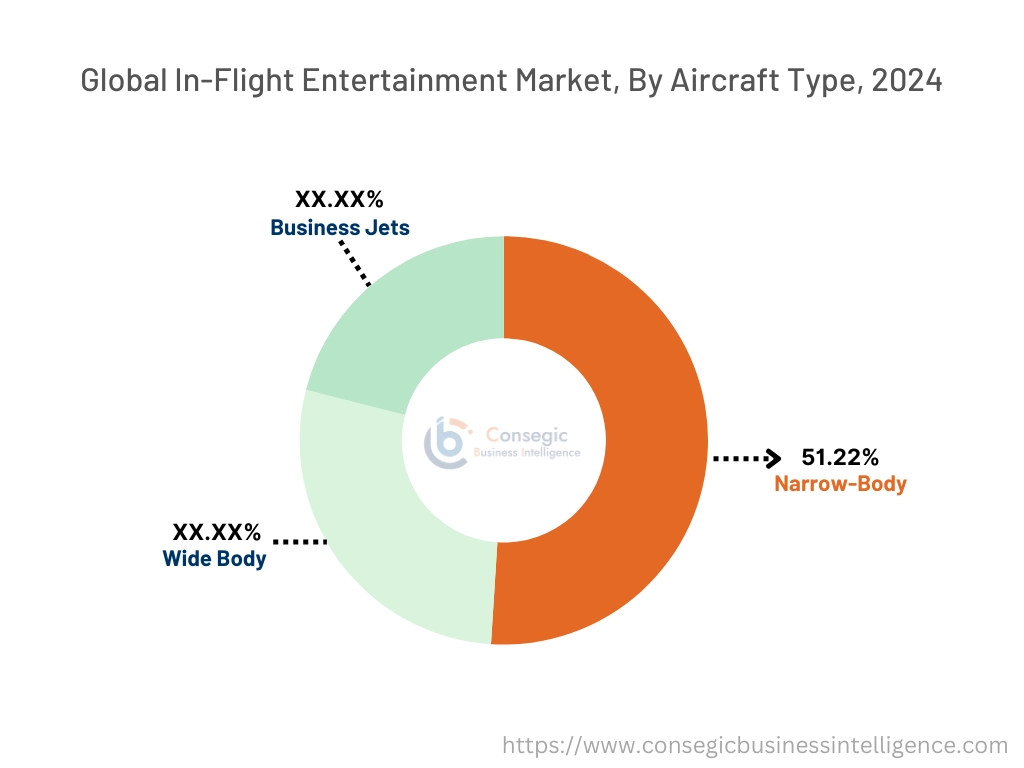
Regional Analysis:
The regions covered are North America, Europe, Asia Pacific, Middle East and Africa, and Latin America.
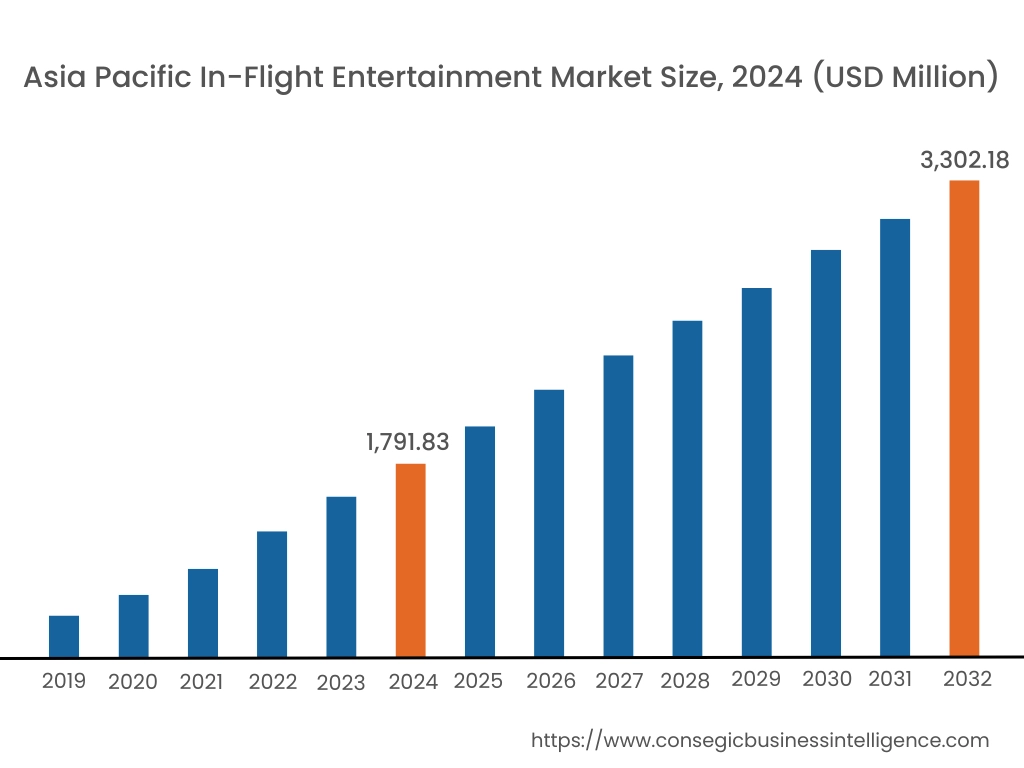
Asia Pacific region was valued at USD 1,791.83 Million in 2024. Moreover, it is projected to grow by USD 1,901.16 Million in 2025 and reach over USD 3,302.18 Million by 2032. Out of this, China accounted for the maximum revenue share of 28.3%. As per regional analysis in-flight entertainment market is mainly driven by growing middle class and increasing investment in aviation infrastructure. Furthermore, growing disposable income, increasing trend of digitalization, technological advancement, and rising passenger traffic are projected to drive the market growth in Asia pacific region during the forecast period.
- For instance, in November 2023, Moment, a leading provider of digital entertainment and e-commerce solutions for the travel industry, has partnered with Nok Air, a prominent low-cost airline in Thailand, to enhance the in-flight infotainment experience for passengers. This partnership is expected to leverage Moment's digital expertise to provide Nok Air passengers with a more engaging and personalized travel experience.
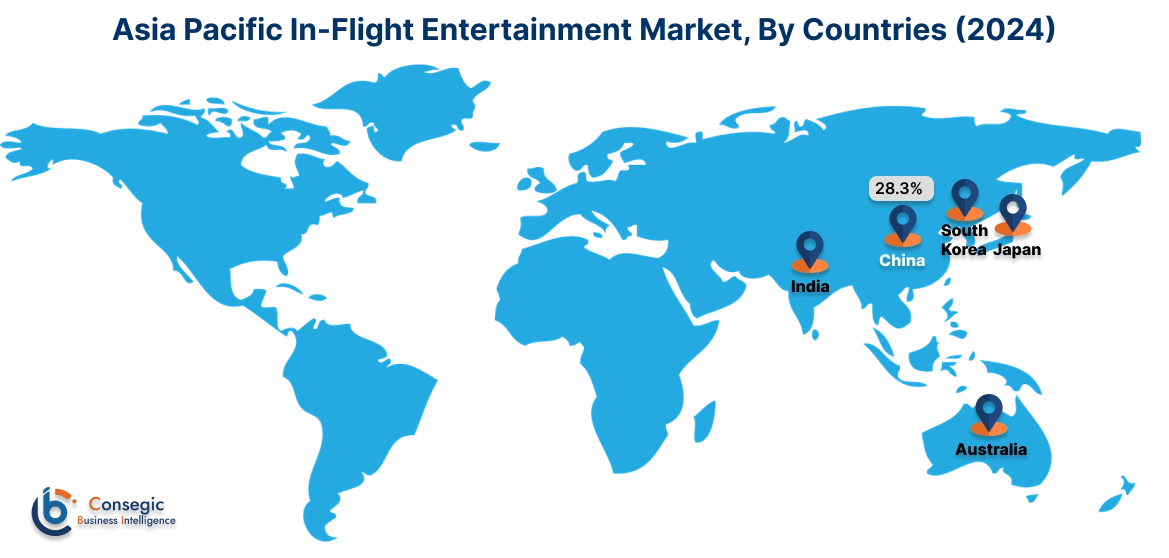
North America is estimated to reach over USD 4,100.02 Million by 2032 from a value of USD 2,284.97 Million in 2024 and is projected to grow by USD 2,418.97 Million in 2025. The North American region's growth is driven by factors including strong airline industry, and technological advancement. Additionally, airlines in North America prioritize passenger satisfaction and are investing heavily in in-flight entertainment systems to provide a competitive edge and enhance the overall travel experience which in turn drives the market.
- For instance, according to Air Transport Action Group (ATAG), 4.7% of all employment and 4.7% of all GDP in the United States and Canada in 2023 contributed by the aviation sector. The presence of large aviation market results in the increased spending on the leisure and entertainment services.
The regional trends analysis depicts that the expansion and modernization of airport infrastructure and increasing demand for business travel in Europe is driving the market. Additionally, the primary factor driving the market in the Middle East and African region include rapid urbanization, rising tourism, and growing government’s investment on airport infrastructure. Further, as per analysis rise of low-cost carriers, increasing disposable income, and increasing infrastructure development is paving the way for the progress of market trend in Latin America region.
Top Key Players and Market Share Insights:
The global in-flight entertainment market is highly competitive with major players providing solutions to the national and international markets. Key players are adopting several strategies in research and development (R&D), product innovation, and end-user launches to hold a strong position in the in-flight entertainment sector. Key players in the in-flight entertainment market include-
- BAE Systems (UK)
- Panasonic Avionics (Japan)
- Collins Aerospace (US)
- Bluebox Aviation Systems (UK)
- Honeywell International Inc. (US)
- Astronics CSC (US)
- ViaSat Inc. (US)
- Gogo Business Aviation (US)
- Lufthansa Group (Germany)
- Thales (France)
- Moment Tech (US)
Recent Industry Developments :
Merger & Acquisition:
- In December 2024, Gogo completed its acquisition of Satcom Direct, creating a leading provider of in-flight connectivity solutions across various segments including business aviation and government mobility.
- In October 2024, Moment, a leader in in-flight digital solutions, has acquired Airfree, a specialist in in-flight e-commerce. This strategic move strengthens Moment's position in transforming the passenger experience and developing innovative solutions for the transportation sector.
Market Expansion:
- In July 2024, Panasonic Avionics, a leading provider of in-flight entertainment, has strengthened its presence in India by opening a new software design and development center in Pune.
In-Flight Entertainment Market Report Insights :
| Report Attributes | Report Details |
| Study Timeline | 2019-2032 |
| Market Size in 2032 | USD 11,081.13 Million |
| CAGR (2025-2032) | 8.4% |
| By Component |
|
| By Deployment |
|
| By Aircraft Type |
|
| By Region |
|
| Key Players |
|
| North America | U.S. Canada Mexico |
| Europe | U.K. Germany France Spain Italy Russia Benelux Rest of Europe |
| APAC | China South Korea Japan India Australia ASEAN Rest of Asia-Pacific |
| Middle East and Africa | GCC Turkey South Africa Rest of MEA |
| LATAM | Brazil Argentina Chile Rest of LATAM |
| Report Coverage |
|
Key Questions Answered in the Report
How big is the In-Flight Entertainment Market? +
The In-Flight Entertainment Market is estimated to reach over USD 11,081.13 Million by 2032 from a value of USD 6,146.29 Million in 2024 and is projected to grow by USD 6,509.29 Million in 2025, growing at a CAGR of 8.4% from 2025 to 2032.
What specific segmentation details are covered in the In-Flight Entertainment report? +
The In-Flight Entertainment report includes specific segmentation details for component, deployment, aircraft type, and regions.
Which is the fastest segment anticipated to impact the market growth? +
In the In-Flight Entertainment Market, the business jet is the fastest-growing segment during the forecast period due to the rising demand for luxury and personalized experiences, technological advancements, growing focus on productivity, and increasing disposable income among high-net-worth individuals.
Who are the major players in the In-Flight Entertainment Market? +
The key participants in the In-Flight Entertainment Market are BAE Systems (UK), Panasonic Avionics (Japan), ViaSat Inc. (US), Gogo Business Aviation (US), Lufthansa Group (Germany), Thales (France), Moment Tech (US), Astronics CSC (US), Collins Aerospace (US), Bluebox Aviation Systems (UK), Honeywell International Inc. (US), and others.
What are the key trends in the In-Flight Entertainment Market? +
The In-Flight Entertainment Market is being shaped by several key trends including trend towards increased demand for high-speed connectivity, focus on personalized experiences, rise of bring-your-own-device (BYOD) solutions, and advancements in technology among others are the key trends driving the market.
